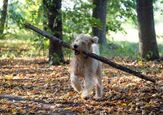Is a Pot-Bellied Pig in Your Future? Read On!

(photo credit: Nolte Lourens / shutterstock.com)
Not since actor George Clooney paid a heartfelt farewell to Max, his 18-year-old pot-bellied pig, did the general public even consider adding a porcine pet to the family. It seems that ever since that public goodbye back in 2006, prospective pet owners have toyed with the idea of strolling to the local park with something smaller than a horse yet bigger than a dog, trotting alongside them. And let’s face it, a pig at the park sounds like a whole lot of fun.
But before you start clearing out your backyard shed…
Things to Consider:
- That cute little porker is going to grow. A lot! And estimates suggest they will hit between 100 and 250 pounds (or more) by the time they’re adults. As most of this growth occurs in the first year, this explains why many of these cuties are available for re-homing around one year of age.
- Talking about age… pot-bellies can live up to 25 years (though typically closer to 15). And that means you should have a “succession plan” in place should your living arrangements change over that time. A plot of land can easily become a condo or retirement residence… and that leaves your little porker in a rather dire situation. Food for thought.
- In some areas, pot bellies are considered livestock rather than pets. In others, they’re classed as an exotic pet. Be sure to check out the rules and legalities for your area before you adopt.
- This type of pet is super smart and highly social. So, relegating him to an outdoor space by himself isn’t going to be fair. Ideally, you should be prepared to adopt two pigs or have other animals they can interact with.
- No surprise, they have an insatiable appetite and need a proper, wholesome diet to remain physically fit versus being overweight. No food scraps or commercial/farm-style foods for this big baby. Choosing wisely, monitoring carefully, and staying on top of all of this can become time-consuming, expensive, and challenging to maintain over the long term.
Still Ready? Let’s Go
If you can tick all of the above boxes and are still enthused about this new family member/s, here are some tips to help make the integration process as seamless as possible.
Time to Eat
Let’s start with your piggy’s food. Table scraps aren’t an appropriate food or supplement to your new pet’s diet. Invest in proper dry food that’s specifically formulated for pot-bellied pigs, such as this vitamin- and mineral-rich option from Manna Pro. It’s specially scented to appeal to snouts of all sizes and is high in digestible fiber and proteins. Or, this mini-pellet, low-dust option kibble for small pigs from Kalmbach. Infused with something called Yucca Schidigera Extract, both this brand and the Manna Pro are formulated to help control unsightly urine odors.
Foods to avoid? Similar to dogs, avoid chocolate, salty foods, anything from the onion family, along with any fruits with pits, such as peaches or avocados – pits can be toxic. Interestingly enough, this little porker should also not be fed dog or cat food, meat products, or gassy vegetables such as broccoli, turnip, cauliflower or kale that can cause an upset stomach.
The Importance of Mental Stimulation
Time for a little mental stimulation, and because these animals are natural-born rooters, this first option is a fun one! I’m loving this snuffle blanket from Piggy Poo and Crew. The larger size is perfect for wandering back and forth as all that rooting, snorting, and munching take place. Best of all, it’s machine-washable – so treats such as fresh fruit or veggie pieces don’t leave marks.
For a fun outdoor activity, intro a simple, covered kids’ sandbox that your pet will enjoy rolling around in or a super-durable treat dispensing toy that’s snout-resistant.
Exercise is Mandatory
Wandering around in a fenced-in pen, backyard, or even having free range throughout your house, isn’t going to be enough exercise to keep your pot-belly fit and healthy. Yes, he’s going to need to be taken on brisk, daily walks of around 20 to 30 minutes per. And no, your dog leash or collar isn’t going to cut it. Your stocky little pet requires a properly sized, adjustable harness designed for pigs, and happily, they exist!
Let’s Clean Up
Hey, messy happens, and even pigs need a refresh from time to time. Now, just like with dogs, you want products specifically designed for their unique needs. That means pH-balanced and free of chemicals, parabens, alcohol and bleaches. And hey, if your little porker can come out smelling like cherries and oatmeal, why not? I’m loving this pet shampoo with scrub brush that’s specifically designed for pigs, dogs, and small animals.
Time for Bed
If your pet pig lives indoors, you’ll want to choose blankets that are easy to tear up. Yes, that love of rooting around is going to result in your porky friend nosing, ripping, and rearranging his bedding to create a cozy nest. So, opt for inexpensive fleece blankets with a tight weave to avoid shredding and thereby loose threads that can be consumed. And like most animals, your pig is going to appreciate a large dog crate or high-bolster bed that adds a little extra security to snooze time.
If he’s going to be located outdoors, straw or pine shavings are the way to go due to their insulating properties. Avoid cedar shavings as the natural oils in cedar can be harmful to pot-bellies.
And lastly, in addition to checking out the legalities in your area, be sure to find a veterinarian that’s ready, willing, and able to take on a pot-bellied pig. Never assume!

Sharing space with three seriously judgy Schnoodles and 2 felines who prefers to be left alone. #LivingMyBestLife
More by Mary Simpson



























